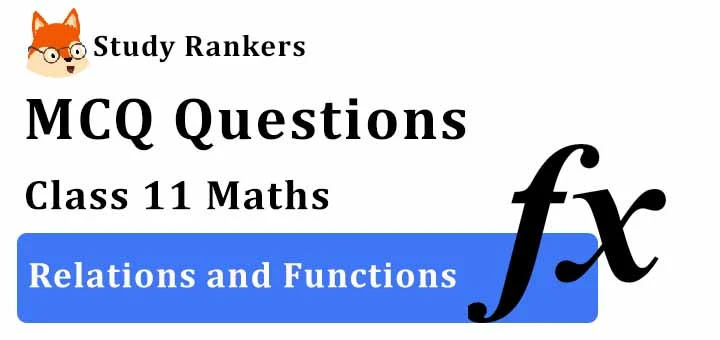MCQ Questions for Class 11 Maths: Chapter 2 Relations and Functions with answers
Chapter 2 Relations and Functions Class 11 Maths MCQ Questions with answers is available here that will help you in knowing the latest pattern of CBSE and understanding the the basic concepts of the chapter. MCQ Questions for Class 11 is very useful in scoring more marks and improving knowledge.

1. The domain of the function f = {(1, 3), (3, 5), (2, 6)} is
(a) 1, 3 and 2
(b) {1, 3, 2}
(c) {3, 5, 6}
(d) 3, 5 and 6
► (b) {1, 3, 2}
2. If n(A) = p and n(B) = q, then how many relations are there from A to B?
(a) pq
(b) 3pq
(c) 2pq
(d) (pq)2
► (c) 2pq
3. In the set W of whole numbers an equivalence relation R defined as follow : aRb iff both a and b leave same remainder when divided by 5. The equivalence class of 1 is given by
(a) {1, 6, 11, 16, ….}
(b) [0, 5, 10, 15,…}
(c) {2, 7, 12, 17…}
(d) {4, 9, 14, 19, …}
► (a) {1, 6, 11, 16, ….}
4. The point on the curve y = x2 which is nearest to (3, 0) is
(a) (1, -1)
(b) (-1,1)
(c) (-1,-1)
(d) (1,1)
► (d) (1,1)
5. If f(x) is an odd differentiable function on R, then df(x)/dx is a/an
(a) Even function
(b) Odd function
(c) Either even or odd function
(d) Neither even nor odd function
► (a) Even function
6. Let S = {1, 2, 3}. The function f : S → S defined as below have inverse for
(a) f = {(1, 2), (2, 2), (3, 3)}
(b) f = {(1, 2), (2, 1), (3, 1)}
(c) f = {(1, 3), (3, 2), (2, 1)}
(d) f = {(1, 3), (2, 3), (2, 1)}
► (c) f = {(1, 3), (3, 2), (2, 1)}
7. The function f(x) = x – [x] has period of
(a) 0
(b) 1
(c) 2
(d) 3
► (b) 1
8. If f (0) = 0, f (1) = 1, f (2) = 2 and f (x) = f (x - 2) + f (x - 3) for x = 3, 4, 5,&.., then f(9) =
(a) 12
(b) 13
(c) 14
(d) 10
► (d) 10
9. Let f (x) = x2 and g (x) = √x, then
(a) (fog) (2) = 4
(b) (gof) (- 2) = 2
(c) (gof) (2) = 4
(d) (fog) (3) = 6
► (b) (gof) (- 2) = 2
10. If A = [a, b], B = [c,d], C = [d, e] then {(a, c), (a, d), (a,e), (b,c), (b, d), (b, e)} is equal to
(a) A∪(B∩C)
(b) A∩(B∪C)
(c) A×(B∩C)
(d) A×(B∪C)
► (d) A×(B∪C)
11. If f(x) = x2 and g(x) = x are two functions from R to R then f(g(2)) is
(a) 4
(b) 8
(c) 1
(d) 2
► (b) 8
12. The number of binary operations on the set {a, b} are
(a) 2
(b) 4
(c) 8
(d) 16
► (d) 16
13. If f (x) is a function such that f (x + y) = f (x) f (y) and f (3) = 125 then f (x) =
(a) 5
(b) x5
(c) 5x
(d) 5x
► (c) 5x
14. The function f : C → C defined by f (x) = ax + b/cx + d for x ∈ C where bd ≠ 0 reduces to a constant function if
(a) a = c
(b) b = d
(c) ad = bc
(d) ab = cd
► (c) ad = bc
15. If A = {1, 2, 3}, and B = {3, 6} then the number of relations from A to B is
(a) 32
(b) 23
(c) 2 x 3
(d) 26
► (d) 26
16. If f(x + y + z) = f(x) f(y) f(z) for all x , y z and if f(2) = 4, f’(0) = 5 and f(0) ≠ 0, then f’(2) is equal to
(a) ±30
(b) ±100
(c) ±80
(d) ±20
► (d) ±20
17. The graph of the function y = f(x) is symmetrical about the line x = 2, then-
(a) f(x+ 2) = f(x – 2)
(b) f(x) = f(–x)
(c) f(2 + x) = f(2 – x)
(d) f(x) = – f(–x)
► (c) f(2 + x) = f(2 – x)
18. On the set Z of all integers define f ; Z → Z as follows : f (x) = x/2 if x is even, and f (x) = 0 if x is odd , then f is
(a) onto but not one-one
(b) into
(c) one-one but not onto
(d) one-one and onto
► (a) onto but not one-one
19. Let R be the relation in the set N given by R = {(a, b): a = b – 2, b > 6}. Choose the correct answer.
(a) (2, 4) ∈ R
(b) (3, 8) ∈ R
(c) (6, 8) ∈ R
(d) (8, 7) ∈ R
► (c) (6, 8) ∈ R
20. The function f(x) = 10x from R to [0, ∞) is
(a) an identity function
(b) one-one and into
(c) a constant function
(d) one-one and onto
► (b) one-one and into
